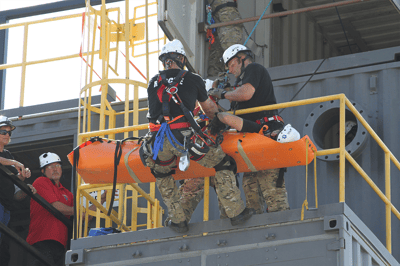Evaluating Your Rescue Service
Evaluating your rescue service helps ensure that the team you have selected has the knowledge, technical skills, and capabilities required to meet your company’s specific needs. In addition, a team evaluation helps fulfill the performance requirements outlined in OSHA 1910.146 and 1926.1211. If you doubt the importance of selecting a competent and properly trained rescue team, consider this disturbing statistic: more than 60% of confined space fatalities occur among would-be rescuers.
 OSHA 1910.146 Appendix F (non-mandatory) provides a great roadmap for employers when choosing and evaluating a confined space rescue team. It contains criteria that may be used to evaluate the capabilities of both prospective and current rescue teams. (Note: Although Appendix F is “non-mandatory”, the standards of 1910.146 are not. Appendix F is OSHA’s recommended method for compliance. Learn why you should pay close attention to Appendix F, even though it is “non-mandatory.”)
OSHA 1910.146 Appendix F (non-mandatory) provides a great roadmap for employers when choosing and evaluating a confined space rescue team. It contains criteria that may be used to evaluate the capabilities of both prospective and current rescue teams. (Note: Although Appendix F is “non-mandatory”, the standards of 1910.146 are not. Appendix F is OSHA’s recommended method for compliance. Learn why you should pay close attention to Appendix F, even though it is “non-mandatory.”)
The Two Components Of A Rescue Service Evaluation:
- An initial evaluation, in which employers decide whether a potential rescue service or team is adequately trained and equipped to perform permit space rescues of the kind needed at the facility and whether such rescuers can respond in a timely manner; and
- A performance evaluation, in which employers assess the skills of a prospective rescue team or rescue service during an actual or practice rescue.
Step 1: Initial Evaluation
The initial evaluation considers:
- A team’s technical skills as evidenced by documented training
- Number of personnel
- Availability
- Timeliness based on the hazards inherent in the space
- Whether they meet the requirements of 1910.146 (k)(2) with regards to access to personal protective equipment (PPE), training in both technical rescue and first aid/CPR, and practice in representative permit-required confined spaces at least once per year
- The ability to notify the employer when they are unable to respond – which is of particular importance for employers using 911 as their rescue service
- and more (see Section A, Initial Evaluation in OSHA 1910.146 Appendix F)
Step 2: Performance Evaluation
Once employers have selected one or more rescue services that meet their criteria on paper, employers should provide the rescue service access to their worksite and ask them to perform in various scenarios of the employer’s choice. Performance evaluations should be administered to a prospective rescue service, as well as to periodically evaluate your current rescue service.
Consider Using A Third Party To Evaluate Your Rescue Service
Employers may opt to use a third party to evaluate their prospective rescue service. Third-party evaluations provide a number of added benefits:
- They are useful when employers may not have the in-house expertise necessary to administer an accurate evaluation, or for employers who prefer having a third-party evaluation as a documented, independent, and unbiased record of the rescue service/team’s capabilities.
- They provide an opportunity for the evaluator to recommend minor changes in equipment or techniques that would enhance the capability of the team.
- In cases where contractors will be providing their own rescue capability, third-party evaluations help ensure that all parties are doing their due diligence where permit space entry is required. Some host employers mistakenly believe that they are relieved of all responsibility when a contractor’s employees are performing the entries. But 1910.146(c)(8) and (9) place reciprocal responsibilities on host and contractor. This includes the host employer informing the contractor that permit space entry is allowed only through compliance with a permit space program meeting the requirements of 1910.146, and the contractor informing the host employer of the permit program it will be following.
Taking the time to ensure that the rescue service you choose has the proficiencies and equipment to perform the specific types of rescue required at your facility could not only prevent injuries, it could even save lives.
If you would like additional information on utilizing Roco Rescue’s documented Team Performance Evaluation for your rescue service, please call 800-647-7626.




